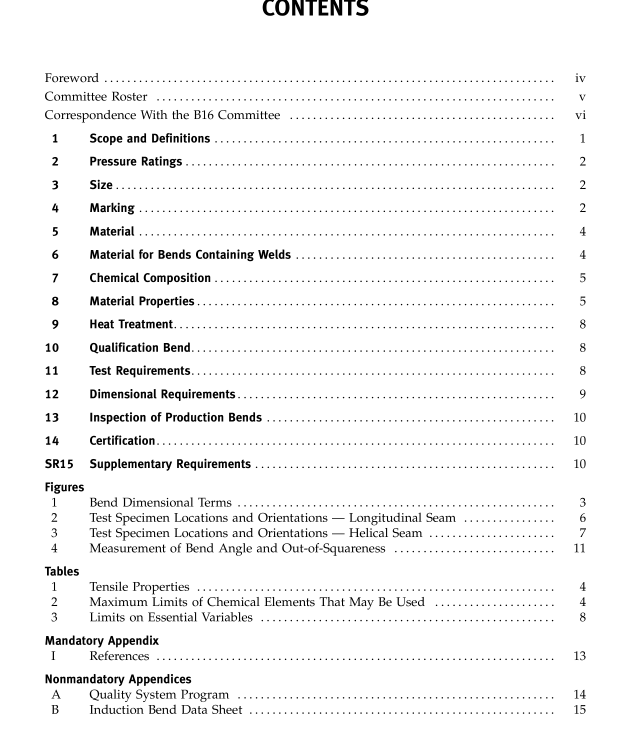ASME B16.49:2007 pdf free download Factory-Made, Wrought Steel, Buttwelding Induction Bends for Transportation and Distribution Systems
1 sCOPE AND DEFINITIONS1.1 General
This Standard covers design, material, manufacturing,testing, marking, and inspection requirements forfactory-made pipeline bends of carbon steel materialshaving controlled chemistry and mechanical properties,produced by the induction bending process,with orwithout tangents.This Standard covers induction bendsfor transportation and distribution piping applications(e.g-,ASME B31.4,B31.8, and B31.11).Process and powerpiping have differing requirements and materials thatmay not be appropriate for the restrictions and examina-tions described herein and, therefore, are not includedin this Standard.
1.2 Manufacturing Process
This process utilizes induction heating to heat a nar-row band 360 deg around a pipe or cylinder at thepoint of bending as the pipe or cylinder is being pushedthrough the inductor coil at a constant velocity. Afterthe material passes through the coil, it may be cooledby forced air or water spray,or it may be allowed tocool in still air. Bends in any producible wall thicknessand diameter are covered. Induction bends covered bythis Standard may be produced from seamless pipe,welded pipe, or cylinders.
1.3 Fabricated Bends
Larger angle bends obtained by girth welding two ormore smaller angle bends together are considered pipefabrications and as such are not within the scope of thisStandard.
1.4Standard Units
The values stated in either metric units or U.S.Cus-tomary units are to be regarded separately as standard.Within the text,Customary values are shown in paren-theses.The values stated in each system are not exactequivalents; therefore, each system must be used inde-pendently of the other. Combining values from two sys-tems may result in nonconformance with the standard.1.5 References
Standards and specifications adopted by reference inthis Standard are shown in Mandatory Appendix I.It is not practical to identify the specific edition of each standard and specification in the individual references. Instead, the specific edition reference is identified in MandatoryAppendix I. Aproductmade inconformance with a prior edition of reference standards and in all other respects conforming to this Standard will be con- sidered to be in compliance.
1.6 Codes and Regulations A bend used under the jurisdiction of a referencing code or governmental regulation is subject to any limita- tion of that code or regulation. This includes any maxi- mum temperature limitation or rule governing the use of a material at low temperature.
1.7 Service Conditions Criteria for selection of bend material for a particular fluid service are not within the scope of this Standard.
1.8 Convention In conformance with this Standard, the convention for fixing significant digits where limits, maximum and minimum values, are specified shall be “rounded off” as defined in ASTM Practice E 29. This requires that an observed or calculated value shall be rounded off to the nearest unit in the last right-hand digit used for expressing the limit. Decimal values and tolerance do not imply a particular method of measurement.
1.9 Quality Systems Requirements relating to the manufacturers’ quality system programs are described in Nonmandatory Appendix A.
1.10 Glossary bend qualification procedure: a document that specifies the properties ofthe starting pipe; the equipmentto be used; the bending parameters; the qualification bend test results; and the postbend, heat-treat equipment and cycle used for the manufacture of the bends. If nonde- structive testing of the bend is required, procedures that have not been approved previously shall be submitted. cylinder: a jointofpipeproducedbyarollingandwelding plate, as opposed to a joint of pipe produced in accor- dance with a recognized specification.
extrados: the outside arc of the bend.itrados: the inside arc of the bend.
minimum (design) wall thickness: the wall thickness speci-fied or computed in accordance with the piping codeas the minimum acceptable for the temperature andpressure application.
nominal (design) wall thickness: the wall thickness speci-fied on the order or marked on the bend.
ovalify, %:[(O.D. max.-O.D. min.)/(O.D. nom)] × 100where o.D. is a linear measurement of the maximum,minimum, or nominal outside diameter.
qualification bend: a bend segment that is produced andtested and is used to qualify the bending procedure.transition zone: the area, at the tangent points of a bend,that covers the change (transition) from unheated toheated material.
NOTE:The terms “bender” and “manufacturer” are used inter-changeably in this Standard.
1.11 Ordering lnformation
The purchaser shall be responsible to specify all theordering information necessary to purchase the neededbends. Examples of such information include, but arenot limited to, the following:
a) quantity
(b) description of bend and nominal dimensions (i.e.,size,bend radius, wall thickness,bend angle,tangentlengths,etc.)
ASME B16.49:2007 pdf free download
